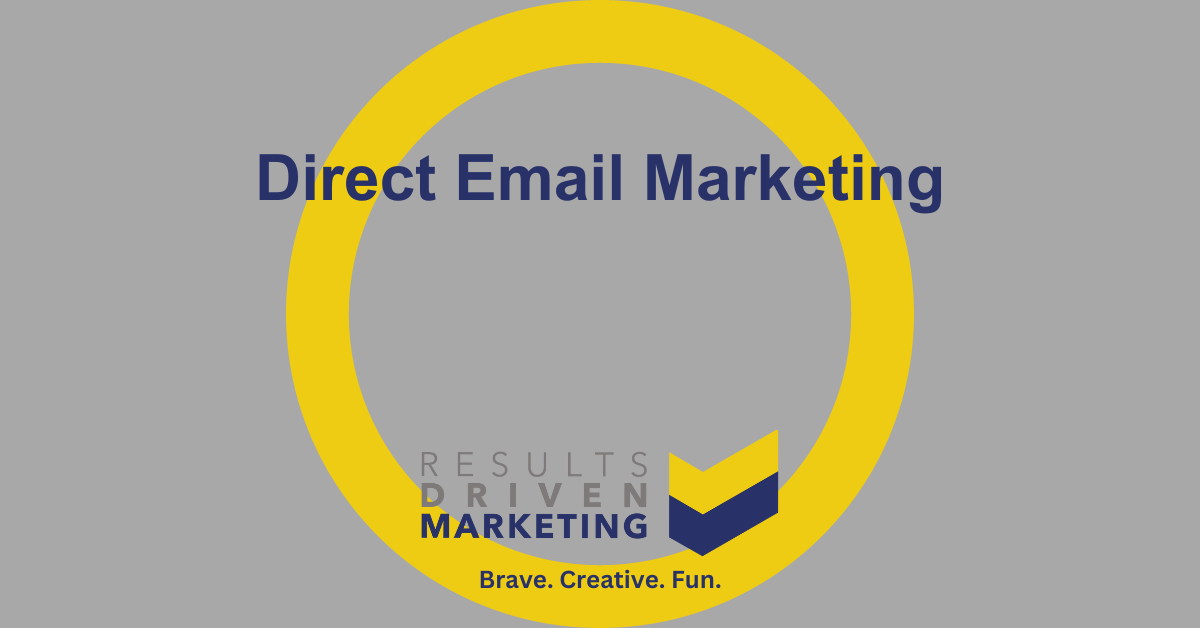
Direct Email Marketing Tips
In the ever-evolving landscape of digital marketing, direct email marketing has emerged as a cornerstone, a pivotal strategy that businesses, both big and small, are increasingly leaning on. It’s more than just sending out emails; it’s about connecting, engaging, and converting.
Table of contents:
What is Direct Email Marketing?
Direct email marketing, at its core, is a targeted approach to reaching out to potential and existing customers through electronic mail. It’s a personalised handshake in a digital world, a way to deliver your message straight to the inbox of your audience.
But it’s not just about pushing content; it’s about crafting messages that resonate, that speak directly to the needs and interests of your recipients. It’s about building relationships, one email at a time.
Advantages and Disadvantages
Like any marketing strategy, direct email marketing comes with its own set of pros and cons. It’s a balancing act, really. Understanding these can help you navigate the waters of email marketing more effectively.
What are the Advantages of Using Direct Email Marketing?
Cost-Effective: One of the most appealing aspects of direct email marketing is its cost-effectiveness. It allows you to reach a large audience without breaking the bank.
Personalisation: Direct email marketing offers the ability to personalise content, making each recipient feel like the message was crafted just for them.
Measurable Results: With direct email marketing, you can track opens, clicks, and conversions, giving you valuable insights into the effectiveness of your campaigns.
Immediate Communication: It allows for quick dissemination of information, keeping your audience updated in real-time.
Wide Reach: Email is ubiquitous. With direct email marketing, you can reach people across the globe with just a click.
What are the Disadvantages of Using Direct Email Marketing?
Overcrowded Inboxes: With so many businesses using email marketing, it’s easy for your message to get lost in a crowded inbox.
Spam Filters: Sometimes, even the most well-crafted emails can end up in the spam folder, unseen by your intended audience.
Design Challenges: Creating emails that look good on all devices and email clients can be a daunting task.
Potential for Unsubscribes: If not done right, direct email marketing can lead to unsubscribes, shrinking your audience.
Legal Compliance: There are laws and regulations governing email marketing, and non-compliance can lead to hefty fines.
Effectiveness and Considerations
Direct email marketing isn’t just a buzzword; it’s a powerhouse in the digital marketing arena. But how effective is it really? And is it the right fit for your business?
Let’s explore these questions and unravel the key considerations you need to keep in mind when embarking on a direct email marketing journey.
How Effective is Using of Direct Email Marketing?
The effectiveness of direct email marketing is, quite frankly, impressive. It’s not just about sending emails; it’s about sending the right emails to the right people at the right time.
When done correctly, direct email marketing can yield significant returns. Studies have shown that for every dollar spent on email marketing, businesses can expect an average return of $42. That’s a substantial ROI, wouldn’t you agree?
Is Using Direct Email Marketing a Good Idea?
Well, the short answer is yes, but let’s not oversimplify things. Direct email marketing is a fantastic idea if you’re looking to build lasting relationships with your customers, keep them informed, and drive sales. It’s a versatile tool that can cater to various objectives, from brand awareness to customer retention.
However, it’s not a one-size-fits-all solution. The success of direct email marketing hinges on understanding your audience and delivering value through your emails.
What are the Key Considerations When Using Direct Email Marketing?
Know Your Audience: Understanding who you’re emailing is crucial. Tailor your content to meet their interests and needs.
Craft Compelling Content: Your emails should be engaging, informative, and, most importantly, relevant to the recipient.
Timing is Everything: The timing of your emails can make or break your campaign. Test and find the sweet spot for when youraudience is most receptive.
Consistency is Key: Regular communication keeps you on your audience’s radar but avoid bombarding them with too manyemails.
Monitor and Adapt: Keep an eye on your metrics. Analyze what’s working and what’s not, and be ready to adapt your strategy accordingly.
Stay Compliant: Adhere to email marketing laws and regulations. Respect your audience’s privacy and their choice to opt-out.
Test, Test, Test: A/B testing can be your best friend. Experiment with different subject lines, content, and layouts to see what resonates best with your audience.
Strategy and Execution
Diving into the world of direct email marketing is like setting sail on a vast ocean. You need a map, a compass, and a clear destination.
Let’s chart the course for creating and executing a direct email marketing campaign that not only reaches the shore but also discovers new territories of success.
How to Create a Direct Email Marketing Campaign
Set Clear Objectives: What do you want to achieve? Whether it’s increasing sales, generating leads, or boosting engagement, having clear goals is essential.
Understand Your Audience: Who are you talking to? Segment your audience and tailor your messages to resonate with each group.
Craft Your Message: What’s your story? Your emails should be compelling, concise, and clear. Remember, it’s not just what you say; it’s how you say it.
Design for Impact: How does it look? Your email’s design should be visually appealing and reflect your brand’s identity.
Test and Optimize: What’s working? Use A/B testing to refine your subject lines, content, and call-to-actions.
Measure and Analyse: How did it perform? Track key metrics like open rates, click-through rates, and conversions to gauge the success of your campaign.
Effective Direct Email Marketing Campaigns
Effective direct email marketing campaigns are those that strike the right chord with the audience. They’re not just about sending emails; they’re about creating experiences, sparking conversations, and building relationships.
Let’s explore the different types of campaigns you can run.
Traffic Generation Email Marketing Campaigns
These campaigns are all about driving traffic to your website or landing page. They’re the digital equivalent of a signpost, guiding your audience to where you want them to go.
Use enticing content and clear call-to-actions to make the journey irresistible.
Awareness Email Marketing Campaigns
Raising awareness is like lighting a beacon in the night. These campaigns aim to put your brand on the map, informing your audience about who you are and what you stand for.
Share your story, your values, and what sets you apart.
Lead Nurturing Email Marketing Campaigns
Lead nurturing is akin to tending a garden. It’s about caring for your potential customers, providing them with valuable information, and guiding them through the buyer’s journey.
It’s a delicate dance of timing and content.
Revenue Generation Email Marketing Campaigns
At the end of the day, it’s about the bottom line. These campaigns focus on converting leads into customers and customers into repeat buyers. Offer exclusive deals, product recommendations, and incentives to encourage purchases.
Design and Content
In the realm of direct email marketing, design and content are the dynamic duo. They work hand in hand to capture attention, convey your message, and compel action.
Let’s dive into how you can create a powerful design and refine your call-to-action.
Create a Powerful Design
Your email’s design is like the packaging of a gift; it sets the stage for what’s inside. Here’s how to make it powerful:
Keep It Clean and Simple: Clutter is the enemy. Opt for a clean, simple design that guides the reader’s eye to the most important elements.
Brand Consistency: Your emails should be an extension of your brand. Use your brand colors, fonts, and style to create a cohesive look.
Optimise for Mobile: In a world where most emails are opened on mobile devices, ensuring your design is mobile-friendly is non-negotiable.
Use Visuals Wisely: A picture is worth a thousand words, but only if it’s the right picture. Use high-quality images that complement your content.
Whitespace is Your Friend: Don’t be afraid of whitespace. It gives your content room to breathe and helps avoid visual overwhelm.
Refine Your Call-to-Action
Your call-to-action (CTA) is the climax of your email. It’s what you’ve been building up to. Here’s how to make it irresistible:
Be Clear and Concise: Your CTA should be straightforward and easy to understand. No beating around the bush.
Create a Sense of Urgency: Use language that encourages immediate action. Phrases like “limited time offer” or “act now” can be effective.
Make It Stand Out: Your CTA should be visually distinct from the rest of your email. Use buttons or contrasting colors to make it pop.
Keep It Above the Fold: Place your CTA where it’s easily seen without scrolling. You want it to be one of the first things the reader sees.
Test and Optimise: Experiment with different CTAs to see what resonates best with your audience. A/B testing can be incredibly insightful here.
Target Audience and Personalisation
In the world of direct email marketing, knowing your audience is like having a compass in uncharted waters. It guides your strategy, ensuring your messages hit the mark.
Personalisation, on the other hand, is like adding a personal touch to a gift; it makes the recipient feel special. Let’s explore how to define your target audience, update your mailing list, and offer value to your customers.
Define Your Target Audience
Identifying your target audience is the first step in any successful direct email marketing campaign. Here’s how to define yours:
Gather Data: Look at your existing customers. What do they have in common? Age, location, interests, and purchasing behaviour are good starting points.
Create Buyer Personas: Develop personas representing your ideal customers. This helps in crafting messages that resonate.
Understand Their Pain Points: What problems do your products or services solve? Understanding this helps in tailoring your content.
Consider Psychographics: Go beyond demographics. Look at values, attitudes, and lifestyle factors that influence buying decisions.
Update Your Mailing List
Your mailing list is the backbone of your direct email marketing efforts. Keeping it updated is crucial. Here’s what you need to do:
Remove Inactive Subscribers: Regularly clean your list by removing those who haven’t engaged with your emails in a while.
Segment Your List: Group your subscribers based on common characteristics or behaviors. This allows for more targeted messaging.
Encourage Updates: Remind your subscribers to update their preferences and information. This ensures your data stays relevant.
Stay Compliant: Always adhere to data protection laws and regulations. Respect privacy and give subscribers an easy way to opt out.
Offer Value to Your Customers
In direct email marketing, value is king. Here’s how to ensure your emails are valuable to your customers:
Educate and Inform: Share tips, insights, and industry news. Position yourself as a valuable resource.
Exclusive Offers: Give your subscribers access to exclusive deals or early product releases.
Personalised Recommendations: Use data to offer personalized product recommendations or content.
Engage and Entertain: Sometimes, a little entertainment goes a long way. Engage your audience with interesting content.
Analysis and Improvement
Direct email marketing is not a set-it-and-forget-it strategy. It’s a cycle of analysis and improvement.
Let’s dive into how to analyse your results and continuously enhance your campaigns.
Analyse Your Results
Track Key Metrics: Open rates, click-through rates, conversion rates, and unsubscribe rates are crucial metrics to monitor.
Understand the Why: Don’t just look at the numbers. Try to understand why certain emails performed well and others didn’t.
Use Feedback: Encourage and pay attention to subscriber feedback. It’s a goldmine of insights.
Test Variations: Continuously test different elements of your emails. Subject lines, content, and design can all impact performance.
Adapt and Evolve: Use your findings to adapt your strategy. What worked yesterday might not work tomorrow. Stay agile.
Alternatives and Complementary Strategies
While direct email marketing is a powerhouse in its own right, it’s not the only player on the field. There are alternatives and complementary strategies that can work in tandem with email marketing or stand alone.
Let’s explore some of these options and see how they can fit into your overall marketing strategy.
What are the Alternatives to Using Direct Email Marketing?
Social Media Marketing: Engage with your audience where they spend a lot of their time. Platforms like Facebook, Instagram, and LinkedIn offer targeted advertising and organic engagement opportunities.
Content Marketing: Create valuable content like blogs, videos, and infographics to attract and retain an audience.
Search Engine Optimisation (SEO): Optimize your website and content to rank higher in search engine results, driving organic traffic.
Pay-Per-Click (PPC) Advertising: Use paid ads on search engines and social media platforms to drive traffic and conversions.
Influencer Marketing: Partner with influencers to tap into their audience and gain credibility.
Can Direct Mail Work with Inbound?
Absolutely! Direct mail can be a powerful component of an inbound marketing strategy. It can be used to:
Nurture Leads: Send personalised mail to leads generated through inbound efforts, moving them further down the funnel.
Enhance Content Delivery: Use direct mail to deliver high-value content like whitepapers or exclusive offers.
Create a Multi-Channel Experience: Combine direct mail with digital channels for a cohesive and impactful customer journey.
FAQ
What is an Email Marketing Campaign?
An email marketing campaign is a series of emails sent to a group of people with the aim of achieving specific goals, such as increasing sales, generating leads, or building brand awareness.
How Much Does Direct Mail Marketing Cost?
The cost of direct mail marketing can vary widely depending on factors like the size of your mailing list, the design and printing costs, and postage fees. It’s important to budget accordingly and consider the potential ROI.
Can You Measure the ROI of Direct Mail Campaigns?
Yes, you can measure the ROI of direct mail campaigns by tracking metrics such as response rates, conversion rates, and the revenue generated from the campaign.
How Can Direct Mail Simplify Account-Based Marketing Efforts?
Direct mail can simplify account-based marketing efforts by offering a tangible, personalized touchpoint. It can help in standing out to high-value accounts and complementing digital outreach.
What is the Average Response Rate for a Direct Mail Campaign?
The average response rate for a direct mail campaign can vary, but according to the Data & Marketing Association, the average response rate is around 5% for house lists and 2.5% for prospect lists.
How to Execute an Email Marketing Campaign?
Executing an email marketing campaign involves defining your goals, segmenting your audience, crafting compelling content, designing your emails, testing, sending, and analysing the results.
What is Direct Mail Marketing?
Direct mail marketing involves sending physical mail, such as postcards, brochures, or catalogs, to a targeted list of recipients with the aim of promoting products, services, or brand awareness.
Who are we?
Dedicated to lead generation, Results Driven Marketing provides myriad services SMEs can trust to deliver results.
Our marketing lists are guaranteed accurate to industry high standards, and GDPR compliant and our experience team means that if you are looking to buy data, they make them totally bespoke and highly relevant whether you are looking for email lists, direct mailing lists or telemarketing lists.
Our email marketing software is highly rated. Responder provides the automation tools you need to put your marketing on autopilot.
We also supply email marketing solutions with our email marketing platform.
Call us today on 0191 406 6399 to discuss your specific needs.
Results Driven Marketing
info@rdmarketing.co.uk
0191 406 6399





